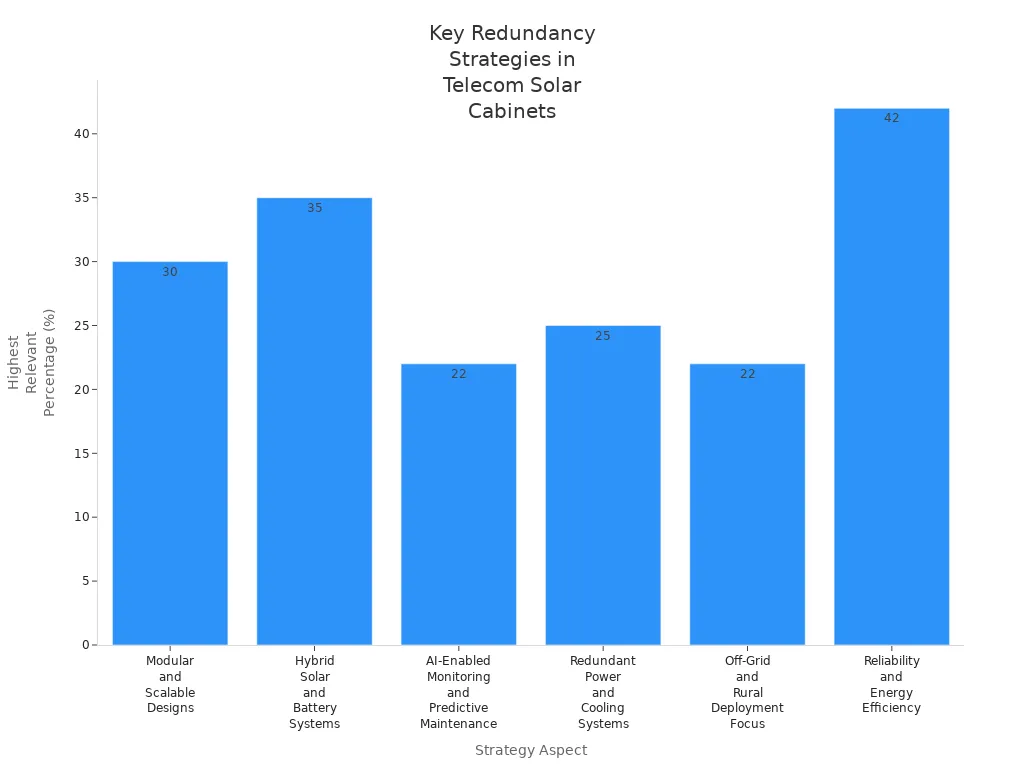Power Redundancy Design for Telecom Cabinet Solar Modules: Cost-Reliability Balance Between 150W & 200W (N+1 Configuration)

To achieve the best cost-reliability balance in telecom cabinet power systems, decision-makers should prioritize N+1 redundancy with the right mix of Solar Modules. For most deployments, 200W units offer higher reliability per module and reduce installation complexity, while 150W modules suit cabinets with strict space or budget constraints. N+1 redundancy ensures uninterrupted operation and minimizes risk.
Key Takeaways
N+1 redundancy adds one extra solar module to ensure continuous power if a module fails, improving system reliability without high costs.
200W solar modules offer higher power and efficiency, saving space and reducing installation time compared to 150W modules.
Choosing 150W modules suits projects with tight budgets or space limits but requires more modules and maintenance.
Modular cabinet designs with stackable and plug-and-play features make upgrades and maintenance easier and support future growth.
Balancing upfront costs, reliability, and space needs helps telecom operators select the best solar modules for their specific site conditions.
N+1 Redundancy
What Is N+1?
N+1 redundancy represents a foundational principle in telecom solar power systems. Engineers design these systems with one additional module beyond the minimum required to support the operational load. For example, if a telecom cabinet needs eight solar modules to meet its power demand, an N+1 configuration installs nine modules. This extra module acts as a passive backup, ready to take over instantly if any primary module fails. The approach eliminates single points of failure and ensures that the system continues to function without interruption.
Tip: N+1 redundancy is widely adopted in telecom solar setups because it balances reliability and cost. Unlike more expensive configurations such as 2N or 2(N+1), N+1 provides robust fault tolerance without excessive investment.
The building block concept supports N+1 redundancy by allowing modular expansion. Each solar module serves as a discrete unit, making it easy to add or replace modules as needed. Passive redundancy modules do not require manual intervention; they automatically compensate for failures, streamlining maintenance and reducing downtime.
Redundancy Type | Configuration Description | Typical System Capacity | Resilience Level | Cost Implication | Common Applications |
|---|---|---|---|---|---|
N+1 | N units plus 1 spare unit | Full load plus 1 spare | Can handle a single failure | Moderate cost | Small to medium data centers, HVAC, backup power for single facilities, including telecom solar power setups |
2N | Two independent sets of N units | Full load in each system | Can handle multiple failures | High cost | Large data centers, hospitals, critical facilities requiring zero downtime |
2(N+1) | Two independent N+1 systems | Full load plus 1 spare in each system | Highest redundancy, handles multiple simultaneous failures | Very high cost | Mission-critical operations such as telecom networks, banking, cloud data centers |
Why It Matters
N+1 redundancy plays a critical role in maintaining continuous operation and maximizing system uptime for telecom cabinets. When a solar module fails, the backup module immediately takes over, preventing service interruptions. This design increases trustworthiness and reduces the risk of downtime, which is essential for telecom networks that require high availability.
Telecom cabinet solar power applications often combine N+1 redundancy with other backup systems, such as batteries and UPS units. Surge protection and high IP-rated enclosures further safeguard equipment from environmental hazards. Regular maintenance and real-time monitoring of voltage, temperature, and state of charge help detect issues early, supporting uninterrupted operation.
Industry guidelines, such as those from the National Institute of Standards and Technology (NIST), encourage redundancy schemes like N+1 to eliminate single points of failure. While formal standards for N+1 in telecom solar power systems remain absent, best practices dictate its use for scalable, resilient infrastructure. The integration of modular building blocks and passive redundancy modules ensures that telecom cabinets can adapt to evolving demands and maintain reliable service.
Solar Modules in N+1

150W vs. 200W
Telecom cabinets often rely on Solar Modules to deliver consistent power. The choice between 150W and 200W modules affects both system performance and cabinet design. A 150W module produces less power and typically has lower efficiency than a 200W module. The 200W module offers higher power density, which benefits installations with limited space. Monocrystalline technology, common in 200W modules, increases efficiency compared to polycrystalline options found in some 150W modules.
When engineers connect Solar Modules in series, the system voltage increases, but the current matches the lowest-rated panel. Mixing 150W and 200W modules in series can limit the overall current to that of the 150W module, reducing total power output and system efficiency. For optimal performance, telecom cabinets should use modules with matching ratings in each string. The 200W modules suit cabinets with higher power demands or restricted installation space, while 150W modules fit projects with budget or space constraints.
Note: Selecting the right module wattage ensures the N+1 configuration delivers reliable power without sacrificing efficiency.
Building Block Design
Modular scalability remains essential for telecom cabinet power systems. Building block design allows engineers to expand or upgrade cabinets as needs change. Stackable configurations maximize vertical space, enabling more Solar Modules without increasing the ground footprint. Adjustable rails and shelves accommodate different equipment sizes, supporting compatibility with new technologies.
Modular Design Feature | Explanation and Benefit |
|---|---|
Stackable Configurations | Allow vertical expansion of cabinets without increasing ground footprint, maximizing space efficiency. |
Adjustable Rails and Shelves | Accommodate different equipment sizes and configurations, ensuring compatibility with new technologies. |
Spare Ports and Plug-and-Play Modules | Simplify integration and upgrades by enabling easy addition or replacement of components. |
Interchangeable Panels and Modules | Enable equipment upgrades without extensive cabinet modifications, supporting future scalability. |
Customizable and Expandable Cabinets | Allow scaling and adapting to future equipment needs without major redesigns. |
Pre-configured Solutions | Reduce installation time and facilitate rapid deployment of upgrades or expansions. |
Proper Sizing | Ensures cabinets can handle current and future power and equipment demands, minimizing costly replacements. |
Efficient Power Distribution Systems | Support evolving power densities, including integration of solar power and other energy sources. |
Modular building blocks support quick upgrades and easy maintenance. Stackable and plug-and-play designs simplify integration, making it easier to add or replace Solar Modules as requirements evolve. This approach ensures telecom cabinets remain flexible, scalable, and ready for future expansion.
Cost Comparison
Upfront Costs
Initial investment plays a significant role in selecting between 150W and 200W modules. The 150W modules usually cost less per unit, making them attractive for projects with tight budgets. However, telecom cabinets require more 150W modules to achieve the same power output as fewer 200W modules. This increase in quantity leads to higher costs for mounting hardware, wiring, and installation labor. The 200W modules, while more expensive per unit, reduce the total number of modules needed. Fewer modules mean lower installation complexity and less hardware.
Module Type | Unit Cost | Modules Needed (for 1200W) | Total Module Cost | Estimated Installation Cost |
|---|---|---|---|---|
150W | Lower | 8 + 1 (N+1) = 9 | Moderate | Higher (more units, labor) |
200W | Higher | 6 + 1 (N+1) = 7 | Slightly Higher | Lower (fewer units, labor) |
Note: Fewer modules can also reduce the size and weight of the cabinet, which may lower shipping and site preparation costs.
Maintenance and Operations
Ongoing maintenance and operational costs depend on the number of modules and system complexity. More modules increase the number of potential failure points. The 150W configuration requires more frequent inspections and replacements over time. Technicians spend more time checking connections and cleaning surfaces. The 200W setup, with fewer modules, simplifies maintenance routines and reduces downtime risk.
Space and weight also affect long-term costs. Cabinets with more modules may need structural reinforcement, which raises total cost of ownership. Fewer, higher-wattage modules help optimize space and minimize weight, supporting easier upgrades and scalability.
Tip: Choosing the right Solar Modules for N+1 redundancy can lower both upfront and ongoing costs, while supporting reliable telecom operations.
Reliability Factors

Failure Rates
Reliability in telecom cabinet power systems depends on the failure rates of each module type. The 200W modules often use advanced cell technologies such as TOPCon, HJT, or IBC. These technologies resist light-induced degradation, which helps maintain stable output over time. In contrast, some 150W modules may use older cell designs that show higher rates of performance loss. Modules certified for potential-induced degradation (PID) resistance, especially those meeting IEC 62804 standards, further reduce the risk of early failure.
Structural features also play a role. Modules with half-cut cells, multi-busbar layouts, or shingled designs show fewer microcracks and hotspots. Fast-response bypass mechanisms, like MOS switches, quickly address partial shading and prevent damage. Regular thermal imaging and temperature monitoring help detect early signs of trouble, allowing for timely maintenance. These features collectively lower the risk of unexpected failures and extend the lifespan of both 150W and 200W Solar Modules.
Uptime and Redundancy
N+1 redundancy directly improves system uptime by providing a backup module that activates if a primary unit fails. This configuration ensures that telecom cabinets continue to operate even during maintenance or unexpected outages. Effective risk mitigation strategies further enhance reliability:
Prioritize N-type cell technologies to resist degradation.
Select modules with PID resistance and advanced structural designs.
Limit string lengths to reduce system voltage and PID risk.
Use inverter reverse bias to counteract PID accumulation.
Conduct shading analysis and optimize module layout.
Follow strict installation protocols to avoid mechanical stress.
Implement regular inspections and temperature monitoring.
Use glass-glass structures with dense encapsulation for durability.
Maintain regular cleaning to prevent localized heating.
These strategies, combined with N+1 redundancy, create a robust system that minimizes downtime and maintains consistent power delivery. By reducing the number of failure points and ensuring quick recovery from faults, telecom operators can trust their power systems to support critical communications infrastructure.
Practical Considerations
Space and Weight
Telecom cabinets often face strict space limitations. Engineers must evaluate the available footprint before selecting Solar Modules. Cabinets with limited space benefit from higher-wattage modules, such as 200W units, which deliver more power per square foot. These modules reduce the total number required, minimizing both the physical footprint and overall weight. Lower-weight systems simplify transportation and installation, especially in remote or rooftop locations.
A comparison table helps illustrate the impact of module selection on space and weight:
Module Type | Number Needed (N+1 for 1200W) | Approx. Area Required | Total Weight |
|---|---|---|---|
150W | 9 | Larger | Heavier |
200W | 7 | Smaller | Lighter |
Cabinet designers must also consider the structural load. Excessive weight can strain mounting hardware and compromise safety. Choosing fewer, higher-capacity modules supports efficient use of space and reduces the risk of overloading the cabinet.
Installation and Scalability
Installation complexity varies with module type and quantity. Fewer Solar Modules mean fewer electrical connections and mounting points, which streamlines the installation process. Technicians complete installations faster and with less risk of wiring errors. This efficiency reduces labor costs and shortens deployment timelines.
Scalability remains a key factor in telecom cabinet design. Modular systems allow operators to expand capacity as demand grows. Cabinets with adjustable rails and plug-and-play features support easy upgrades. Environmental factors, such as temperature extremes and exposure to dust or moisture, influence installation choices. Engineers select modules with robust enclosures and high IP ratings to ensure reliable operation in harsh conditions.
Tip: Planning for future expansion during initial installation saves time and resources. Modular cabinet designs and scalable Solar Modules help telecom operators adapt to changing power requirements.
Decision Matrix
Cost vs. Reliability
Decision-makers often face a challenge when balancing cost and reliability in telecom cabinet power systems. The following table compares the main trade-offs between 150W and 200W modules in N+1 redundancy configurations:
Criteria | 150W Modules | 200W Modules |
|---|---|---|
Upfront Cost | Lower per unit, higher total | Higher per unit, lower total |
Installation Complexity | More units, more wiring | Fewer units, simpler wiring |
Space Requirement | Larger footprint, heavier | Smaller footprint, lighter |
Maintenance | More frequent checks, more points of failure | Easier, fewer points of failure |
Reliability | Adequate with N+1, lower per module | Higher per module, robust with N+1 |
Scalability | Flexible, but may require cabinet upgrades | Highly scalable, easier expansion |
Note: Operators should consider both immediate costs and long-term reliability when selecting module wattage.
Scenario Guidance
Selecting the right module depends on deployment conditions. The following recommendations help guide decision-makers:
Remote or Space-Limited Sites
Choose 200W modules. These units maximize power output in tight spaces and reduce installation time.Budget-Constrained Projects
Opt for 150W modules. They offer lower upfront costs, though they require more frequent maintenance.High-Reliability Requirements
Select 200W modules with advanced cell technology. These modules provide greater uptime and minimize risk.Scalable Infrastructure
Use cabinets with modular designs. Both module types support expansion, but 200W modules simplify upgrades.Harsh Environments
Prioritize modules with robust enclosures and high IP ratings. Reliability takes precedence over cost in these scenarios.
Operators should match module selection to site needs, budget, and reliability targets. A careful review of the decision matrix ensures optimal performance and cost efficiency.
Recommendations
Choosing 150W
Telecom operators often select 150W modules for projects with strict budget or space limitations. These modules fit cabinets with lower power requirements or where expansion is unlikely. Operators should assess the criticality of the telecom application before finalizing the module choice. Lower-wattage modules suit installations where occasional downtime is acceptable and where cost savings take priority.
Best practices for deploying 150W modules include:
Evaluate the total cost of ownership, including installation and maintenance.
Use modular rectifier designs to support easy maintenance and scalability.
Implement load-sharing among modules to reduce thermal stress.
Plan for future upgrades by ensuring cabinets can accommodate additional modules if needed.
Regularly review redundancy strategies as operational needs change.
Operators should avoid inefficient power sharing and increased system complexity, which can undermine reliability. Structured decision-making, including risk assessment and design optimization, helps maintain balance between cost and reliability.
Choosing 200W
Operators often choose 200W modules for sites with high reliability requirements or limited installation space. These modules deliver more power per unit, reducing the number of modules needed and simplifying installation. Higher-wattage modules suit cabinets in remote or critical locations where downtime must remain minimal.
Recommended practices for 200W module selection:
Conduct a cost-benefit analysis to weigh capital expenses against reliability gains.
Select modules with advanced cell technology and robust enclosures for harsh environments.
Use hot-swappable modular designs to minimize downtime during maintenance.
Implement load-sharing to extend module lifespan and maintain energy efficiency.
Consider environmental and regulatory factors that may require higher redundancy.
Plan for scalability to support future growth in power demand.
Criteria | 150W Modules | 200W Modules |
|---|---|---|
Budget | Suits tight budgets | Higher initial investment |
Reliability | Adequate for non-critical | Preferred for critical sites |
Space Efficiency | Requires more cabinet space | Maximizes power density |
Maintenance | More frequent checks | Easier, less frequent |
Scalability | Flexible, may need upgrades | Highly scalable |
Regularly reviewing redundancy strategies ensures that telecom cabinets maintain optimal performance as business needs evolve. Operators should avoid standby module delays and inefficient power sharing to maximize reliability.
Telecom operators achieve optimal cost and reliability by matching module selection to site needs and using N+1 redundancy. Modular, scalable designs and hybrid solar-battery systems support future growth and energy efficiency. AI-enabled monitoring and integrated battery management improve uptime. The table below highlights key strategies for applying these insights:
Strategy Aspect | Supporting Data / Insight |
|---|---|
Modular and Scalable Designs | 30% of deployments focus on flexible modularity. |
Hybrid Solar and Battery Systems | Delta Electronics' hybrid cabinets reduce grid dependency by 30%. |
AI-Enabled Monitoring | 22% of deployments use predictive maintenance for higher reliability. |
Reliability and Energy Efficiency | 42% of updates target energy efficiency; upgrades cut network downtime by 30%. |

Applying these best practices ensures robust, future-ready telecom cabinet power systems.
FAQ
What does N+1 redundancy mean for telecom solar modules?
N+1 redundancy means the system includes one extra solar module beyond the minimum required. This design ensures continuous operation if one module fails. Telecom operators use this approach to improve reliability and reduce downtime.
How do 150W and 200W modules affect installation time?
Technicians install fewer 200W modules, which reduces wiring and mounting tasks. The 150W modules require more units, increasing installation time. Most projects benefit from the faster deployment of higher-wattage modules.
Tip: Fewer modules simplify installation and lower labor costs.
Which module type offers better long-term reliability?
200W modules often use advanced cell technology and robust materials. These features increase resistance to degradation and failure. Operators choose 200W modules for critical sites that demand high reliability.
Module Type | Reliability Level |
|---|---|
150W | Standard |
200W | High |
Can operators mix 150W and 200W modules in one cabinet?
Mixing different wattages in a single string reduces system efficiency. Engineers recommend using modules with matching ratings for optimal performance. This practice ensures balanced power output and simplifies maintenance.
What factors influence the total cost of ownership?
The total cost includes module price, installation, maintenance, and cabinet upgrades. Fewer, higher-wattage modules lower installation and maintenance expenses. Operators should consider space, reliability, and future scalability when calculating costs.
See Also
Battery And Solar Inverter Systems Linked To Telecom Cabinets
Solar Energy Storage Solutions Designed For Telecom Cabinets
Steps To Guarantee Consistent Power For Telecom Cabinets
Methods To Calculate Power Systems And Batteries For Telecom
Essential Materials Needed For Outdoor Telecom Cabinet Construction
CALL US DIRECTLY
86-13752765943
3A-8, SHUIWAN 1979 SQUARE (PHASE II), NO.111, TAIZI ROAD,SHUIWAN COMMUNITY, ZHAOSHANG STREET, NANSHAN DISTRICT, SHENZHEN, GUANGDONG, CHINA

